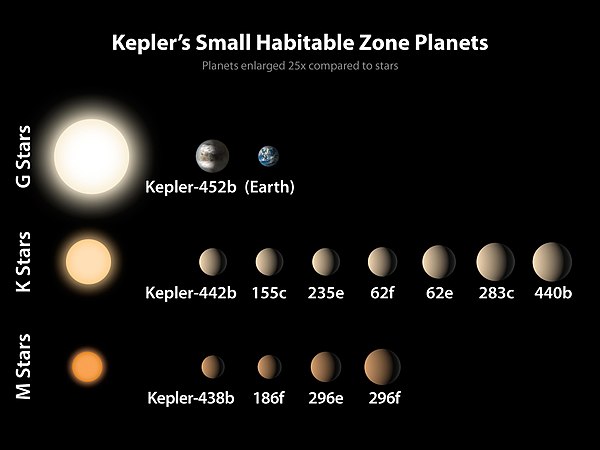Kepler-452b
Template:Planetbox begin Template:Planetbox image Template:Planetbox star Template:Planetbox character Template:Planetbox discovery Template:Planetbox orbit Template:Planetbox catalog Template:Planetbox reference Template:Planetbox end
Kepler-452b (sometimes nicknamed Earth 2[1][2]) is an exoplanet orbiting the G-class star Kepler-452. It was identified by the Kepler space telescope, and its discovery was announced by NASA on 23 July 2015.[3] It is the first potentially rocky super-Earth[4] planet discovered orbiting within the habitable zone of a star very similar to the Sun.[5]
The planet is about 1,400 light-years away from the Solar System; at the speed of the New Horizons spacecraft, about 59,000 km/h (37,000 mph), it would take approximately 26 million years to get there.[6]
Properties
Kepler 452b takes 385 Earth days to orbit its star.[7] It is 60% bigger than Earth, and lies within the conservative habitable zone of its parent star.[8][9]
It has a probable mass five times that of Earth, and its surface gravity is twice Earth's, though calculations of mass for exoplanets are only rough estimates.[8] If it is a terrestrial planet, it is most likely a super-Earth with many active volcanoes due to its higher mass and density. The clouds on the planet would be thick and misty, covering much of the surface as viewed from space. From the surface, its star Kepler-452 would look almost identical to the Sun as viewed from the Earth.[10]
It is not known if Kepler-452b is a rocky planet or a small gas planet,[1] but based on its small radius, Kepler-452b has a reasonable chance of being rocky.[3] It is not clear if Kepler-452b offers habitable environments. It orbits a G2V-type star, like the Sun, with nearly the same temperature and mass and 20% more luminous.[7] However, the star is six billion years old, making it 1.5 billion years older than the Sun. At this point in its star's evolution, Kepler-452b is receiving 10% more energy from its parent star than Earth is currently receiving from the Sun.[5] If Kepler-452b is a rocky planet, it may be subject to a runaway greenhouse effect similar to that seen on Venus.[11] However, due to the planet being 60% bigger than Earth, it is likely to have an estimated mass of 5 M⊕, which would protect Kepler-452b from succumbing to the runaway greenhouse effect for another 500 million years.[11] This could allow potential life on the surface to continue to evolve.
| Notable Exoplanets – Kepler Space Telescope |
|---|

|
Habitability potential
Scientists with the SETI (Search for Extraterrestrial Intelligence) Institute have already begun targeting Kepler 452b, the first near-Earth-size world found in the habitable zone of a Sun-like star.[12] SETI Institute researchers are using the Allen Telescope Array, a collection of 6-meter (20 feet) telescopes in the Cascade Mountains of California, to scan for radio transmissions from Kepler-452b. So far, the array has scanned the exoplanet on over 2 billion frequency bands, with no result. The telescopes will continue to scan over a total of 9 billion channels, searching for alien radio signals.[12]
Observation and exploration
Kepler-452b is 1,400 light years from Earth - and each light year is 5.88 trillion miles - which means it would take the best part of a millennium-and-a-half to reach it if a spacecraft could travel at the speed of light.[2]
But the speed of light is more than 670 million Mph (186,000 mi/s) and the fastest current space craft - the New Horizons unmanned probe that passed Pluto in July of 2015 - travels at just 35,187 Mph.[2]
It took New Horizons 10 years to reach Pluto - which is three billion miles from us - meaning it would be about 26 million years before it reached Kepler-452b, clearly an unthinkable amount of time.[2]
Gallery
-
A diagram of the orbit of Kepler-452b within the Kepler-452 system, as compared to the inner Solar System and Kepler-186 system, and their respective projected habitable zones. -
This artist's concept compares Earth (left) to Kepler-452b, which is about 60% larger in diameter. -
Comparison of Kepler-452b and related exoplanets with Earth
See also
References
- ^ a b Rincon, Paul (23 July 2015). "'Earth 2.0' found in Nasa Kepler telescope haul". BBC News. Retrieved 24 July 2015.
- ^ a b c d Kepler-452b: How long would it take humans to reach 'Earth 2' and could we live there?
- ^ a b Jenkins, Jon M.; Twicken, Joseph D.; Batalha, Natalie M.; et al. (23 July 2015). "Discovery and Validation of Kepler-452b: A 1.6 R⨁ Super Earth Exoplanet in the Habitable Zone of a G2 Star" (PDF). The Astronomical Journal. 150 (2): 56. arXiv:1507.06723. Bibcode:2015AJ....150...56J. doi:10.1088/0004-6256/150/2/56. ISSN 1538-3881. Retrieved 24 July 2015.
- ^ "The Habitable Exoplanets Catalog – Planetary Habitability Laboratory @ UPR Arecibo". upr.edu.
- ^ a b Chou, Felicia; Johnson, Michele (23 July 2015). "NASA's Kepler Mission Discovers Bigger, Older Cousin to Earth" (Press release). NASA. Retrieved 23 July 2015.
- ^ "NASA telescope discovers Earth-like planet in star's 'habitable zone". BNO News. 23 July 2015. Retrieved 23 July 2015.
- ^ a b Overbye, Dennis (23 July 2015). "Kepler Data Reveals What Might Be Best 'Goldilocks' Planet Yet". The New York Times. Retrieved 23 July 2015.
- ^ a b Feltman, Rachel (23 July 2015). "Scientists discover 12 new potential Earth-like planets". The Washington Post. Retrieved 23 July 2015.
- ^ Witze, Alexandra (23 July 2015). "NASA spies Earth-sized exoplanet orbiting Sun-like star". Nature. Retrieved 23 July 2015.
- ^ NASA Kepler press conference. 23 July 2015.
- ^ a b Lugmayr, Luigi (23 July 2015). "Kepler-452b details unveiled". I4U News. Retrieved 23 July 2015.
- ^ a b SETI Targets Kepler-452b, Earth's 'Cousin,' in Search for Alien Life







